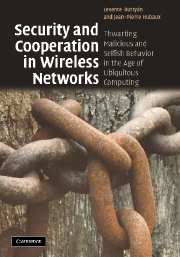 Security and Cooperation in Wireless Networks
Security and Cooperation in Wireless Networks Book contents
- Frontmatter
- Contents
- Preface
- Acknowledgements
- Part I Introduction
- Part II Thwarting malicious behavior
- 4 Naming and addressing
- 5 Establishment of security associations
- 6 Securing neighbor discovery
- 7 Secure routing in multi-hop wireless networks
- 8 Privacy protection
- Part III Thwarting selfish behavior
- Appendix A Introduction to cryptographic algorithms and protocols
- Appendix B A tutorial on game theory for wireless networks
- References
- Index
5 - Establishment of security associations
from Part II - Thwarting malicious behavior
Published online by Cambridge University Press: 05 June 2012
- Frontmatter
- Contents
- Preface
- Acknowledgements
- Part I Introduction
- Part II Thwarting malicious behavior
- 4 Naming and addressing
- 5 Establishment of security associations
- 6 Securing neighbor discovery
- 7 Secure routing in multi-hop wireless networks
- 8 Privacy protection
- Part III Thwarting selfish behavior
- Appendix A Introduction to cryptographic algorithms and protocols
- Appendix B A tutorial on game theory for wireless networks
- References
- Index
Summary
In the previous chapter, we have seen how a given device can be properly and un-ambiguously designated by a name or an address. In this chapter, we will explain how two wireless devices can securely identify each other and get ready to communicate securely with each other; in other words, we will see how they can perform authentication and key establishment.
Authentication and key establishment are strongly related to each other, because of their mutual dependency: once two (or more) entities have authenticated each other, they can usually establish a key, in order to secure their future communications; conversely, an already established key can be very useful to perform future authentication.
These two operations are considered to be among the most fundamental (if not the two most fundamental) mechanisms of network security. As a result, a huge number of protocols have been proposed (and a sizeable number of them have already been standardized and implemented) in order to support authentication and key establishment in (wired) networks. The choice of a protocol depends notably on the role of the trusted server (if any), on whether the key is established by one of the principals (and then transported to the other(s)) or agreed among the principals, and on the underlying cryptographic mechanisms (symmetric or asymmetric).
- Type
- Chapter
- Information
- Security and Cooperation in Wireless NetworksThwarting Malicious and Selfish Behavior in the Age of Ubiquitous Computing, pp. 103 - 140Publisher: Cambridge University PressPrint publication year: 2007


